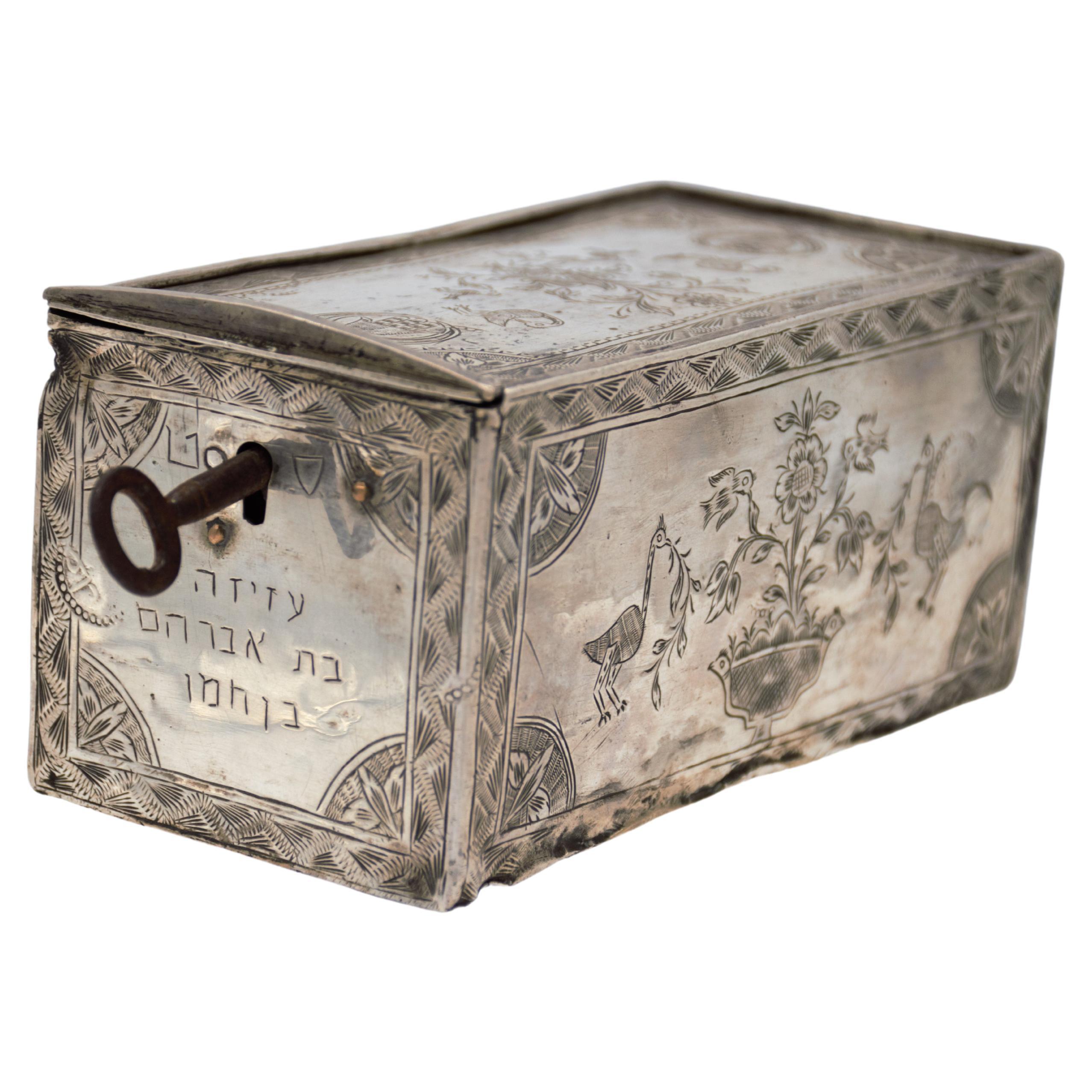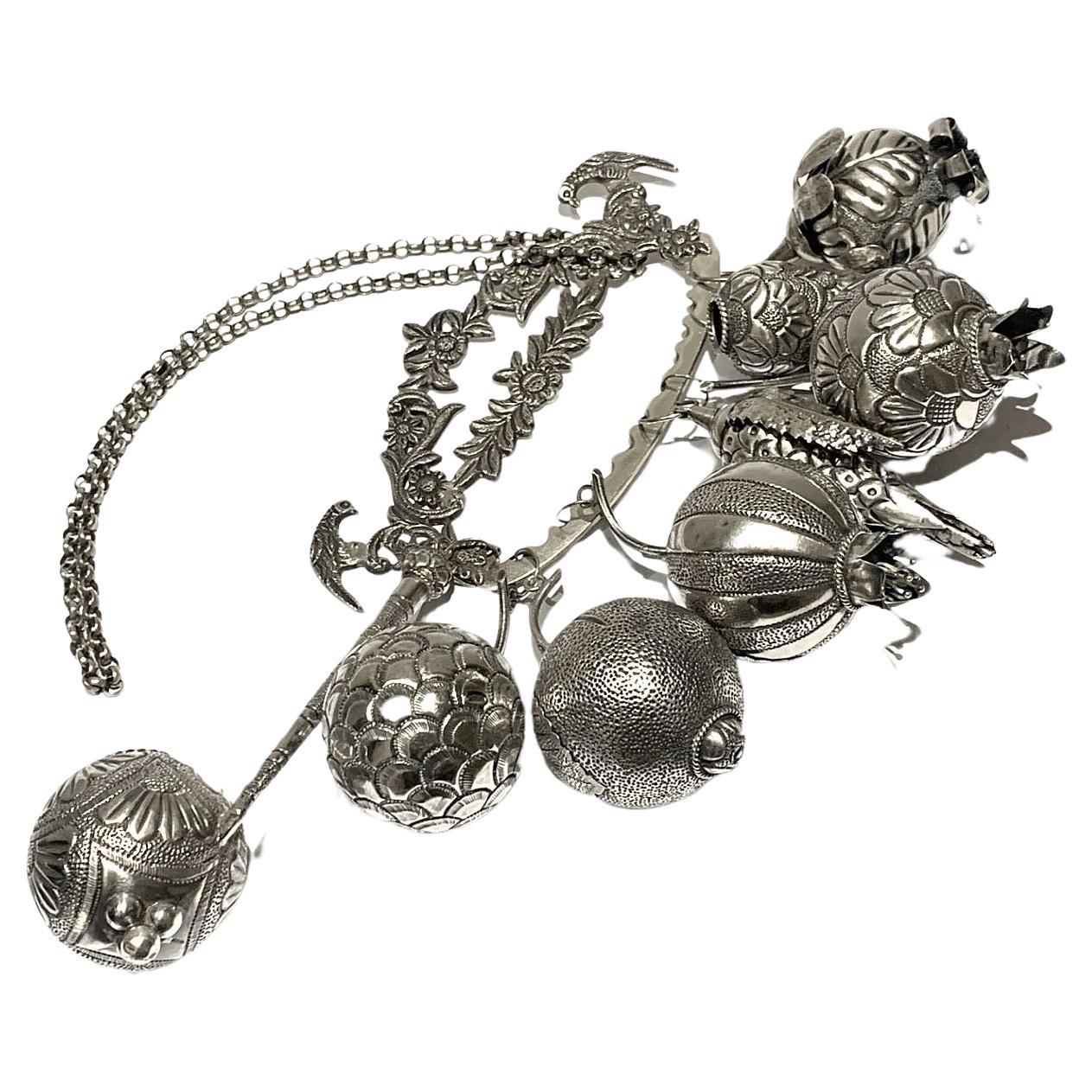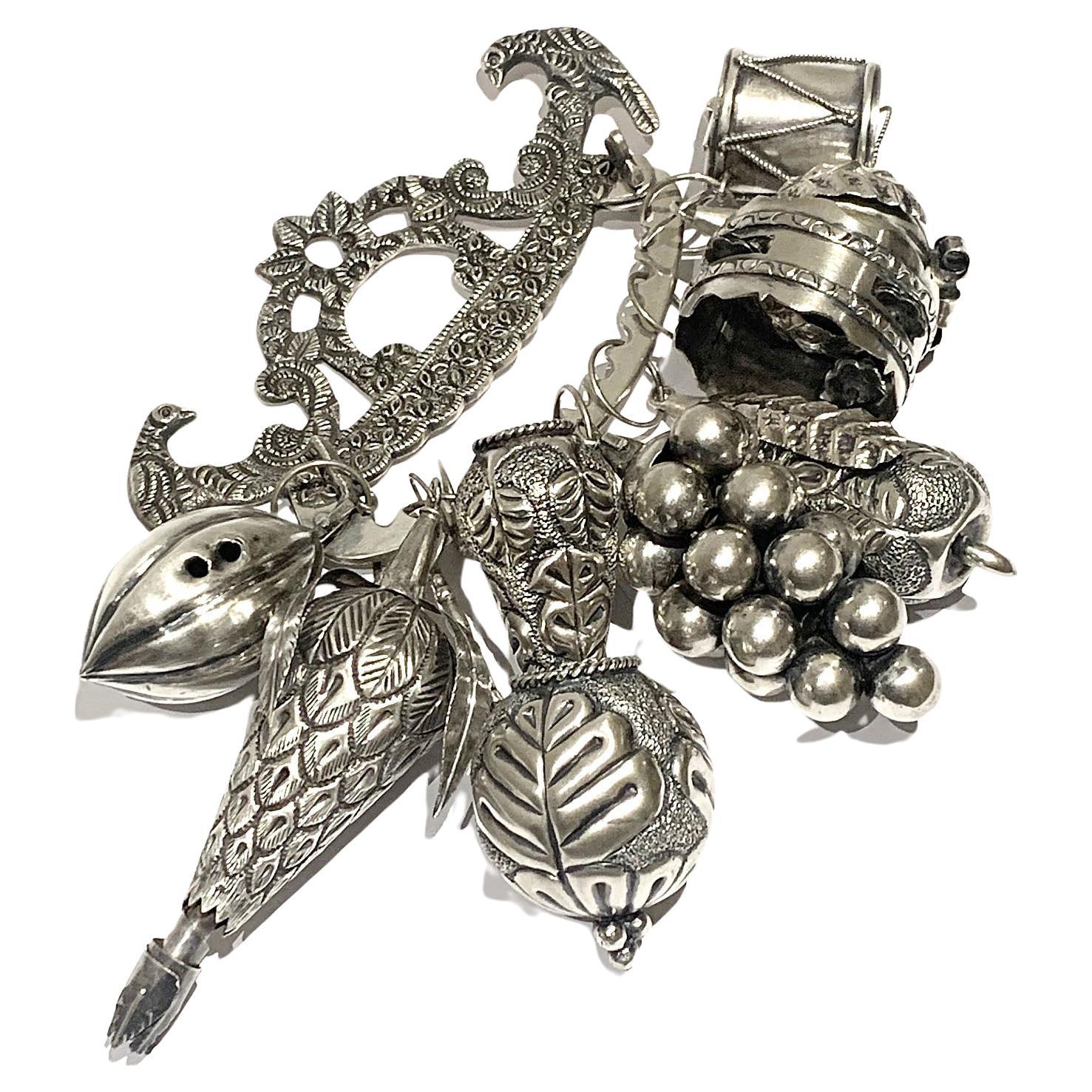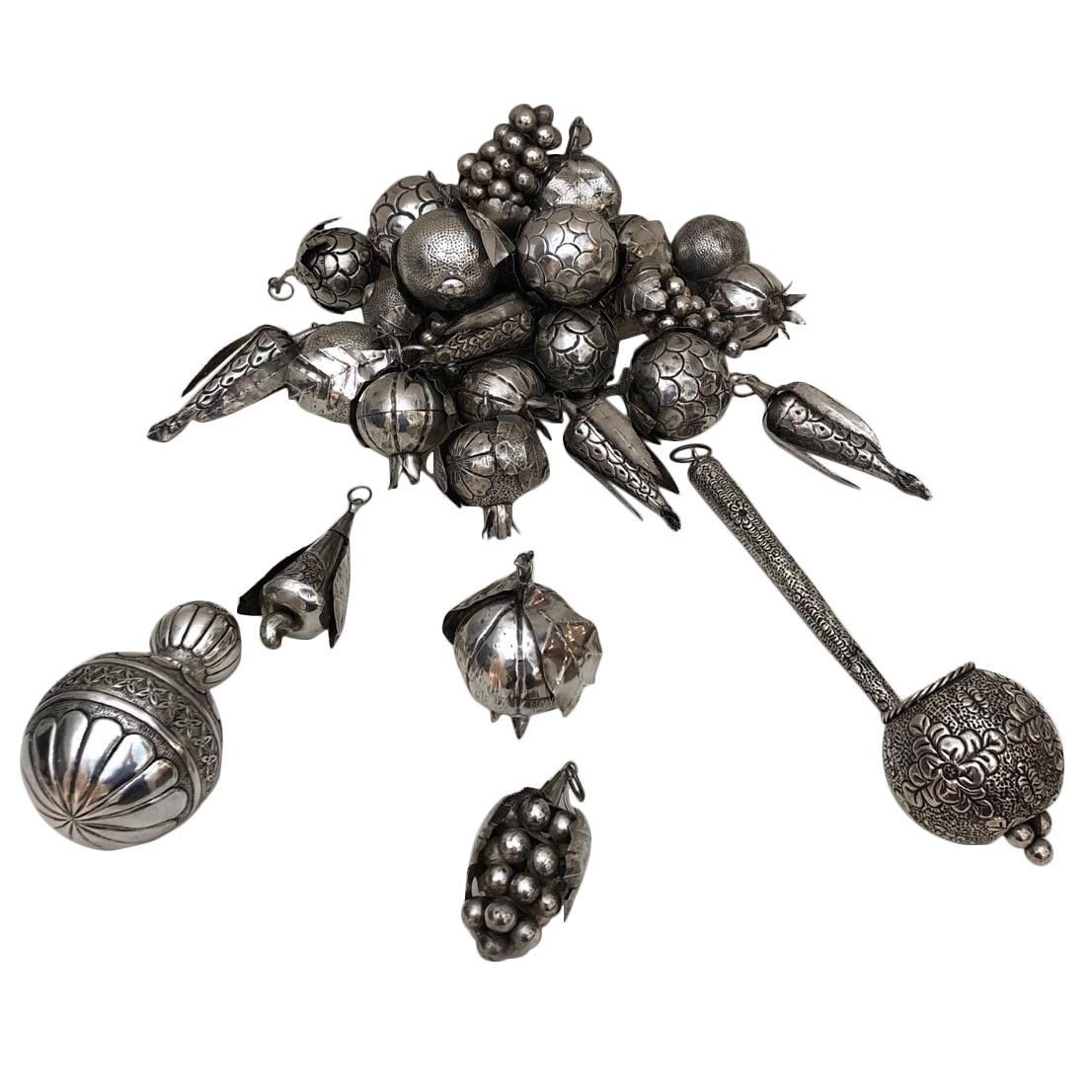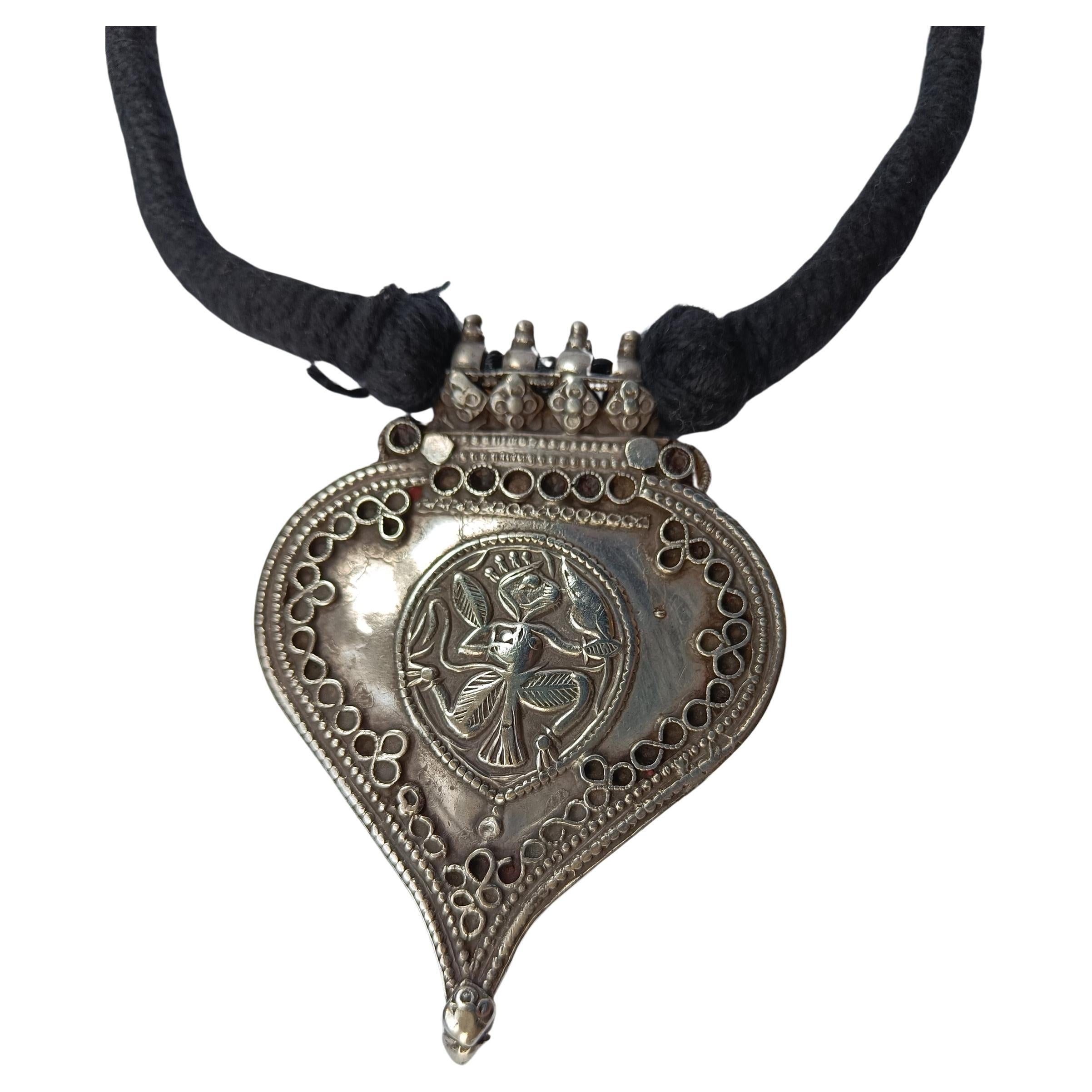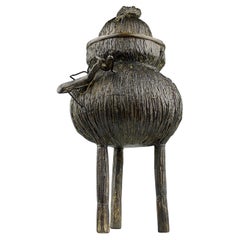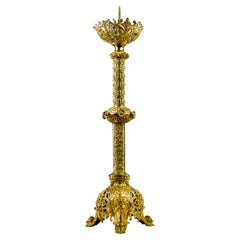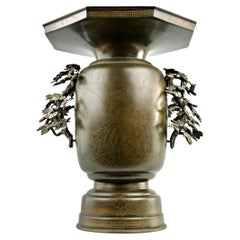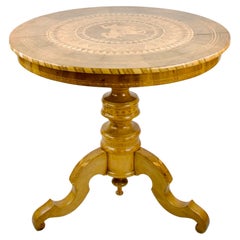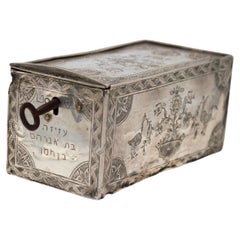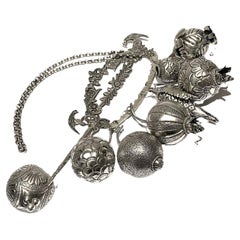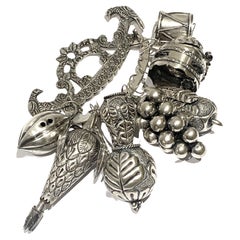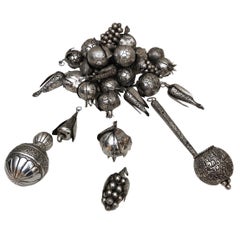Items Similar to Oman, Silver & Gold Necklace with Amulet Box, 19th Century
Want more images or videos?
Request additional images or videos from the seller
1 of 6
Oman, Silver & Gold Necklace with Amulet Box, 19th Century
About the Item
Stunning and rare Omani tribal necklace in gold and silver featuring eight Burgau thalers dated 1780 and a large amulet box (Hirz) also in gold and silver. 19th century.
Very good condition. Preserved and professionally framed.
Dimensions of the necklace: 52 x 30 x 3
Dimensions of the frame: 70 x 47 x 5
Secure shipping.
This fine Omani necklace of silver and gold comprises two strands of spiky, seed pod-like silver beads; gold-wrapped beads; eight silver Maria Theresa thaler coins; and a large silver and gold amulet box, with multiple chain tassels each of which finishes with a square-shaped pendant cut from sheet silver.
The cigar-shaped amulet box called hirz would have contained some Koranic verse or religious text.
Such a spectacular display of wealth would only have been worn at times of important festivities such as marriage celebrations.
Maria Theresa thalers were made in Austria since the reign of Empress Maria Theresa of the Austro-Hungarian Empire. The Empress died in 1780 and since that time, all thalers that were subsequently struck were minted with that date regardless of the actual year that they were produced. The coins achieved such a level of trust for their silver content (which is 83.3% silver) in the Middle East that neither the design not the date was varied, and so for more than 200 years the coins were used as an international currency among the tribes and the states of the Middle East, in much the same way as the Spanish dollar was used as an international currency at the time elsewhere. The thalers were used to complete most important transactions locally and were also given as dowries. They were also an important source of silver and were melted locally for jewellery.
The coins made their way to the ports of the Red Sea, Egypt and northern Africa from the ports of Genoa, Trieste, Livorno and Marseille. European traders used the coins to buy precious materials from the Gulf and northern Africa which it desired – commodities such as spices, coffee, gum Arabic, indigo, pearls, and tortoise shell.
The importance and the beauty of the coins saw them incorporated into local jewellery most particularly in Oman and Yemen.
References
Al-Jadir, S., Arab & Islamic Silver, Stacey International, 1981.
Harrigan, P., ‘Tales of a Thaler’, Saudi Aramco World, January/February 2003.
Hawley, R., Omani Silver, Longman, 1978.
Hawley, R., Silver: The Traditional Art of Oman, Stacey International, 2000.
Rajab, J.S., Silver Jewellery of Oman, Tareq Rajab Museum, 1998.
Ransom, M., Silver Treasures from the Land of Sheba: Regional Yemeni Jewelry, AUC Press, 2014.
- Dimensions:Height: 20.48 in (52 cm)Width: 11.82 in (30 cm)Depth: 1.19 in (3 cm)
- Materials and Techniques:
- Place of Origin:Oman
- Period:
- Date of Manufacture:19th Century
- Condition:Wear consistent with age and use.
- Seller Location:PARIS, FR
- Reference Number:1stDibs: LU8131234682102
About the Seller
5.0
Vetted Professional Seller
Every seller passes strict standards for authenticity and reliability
Established in 2020
1stDibs seller since 2023
16 sales on 1stDibs
Typical response time: <1 hour
- ShippingRetrieving quote...Shipping from: PARIS, France
- Return Policy
Authenticity Guarantee
In the unlikely event there’s an issue with an item’s authenticity, contact us within 1 year for a full refund. DetailsMoney-Back Guarantee
If your item is not as described, is damaged in transit, or does not arrive, contact us within 7 days for a full refund. Details24-Hour Cancellation
You have a 24-hour grace period in which to reconsider your purchase, with no questions asked.Vetted Professional Sellers
Our world-class sellers must adhere to strict standards for service and quality, maintaining the integrity of our listings.Price-Match Guarantee
If you find that a seller listed the same item for a lower price elsewhere, we’ll match it.Trusted Global Delivery
Our best-in-class carrier network provides specialized shipping options worldwide, including custom delivery.More From This Seller
View AllIncense Burner, Japan, 19th Century
Located in PARIS, FR
Beautiful incense burner in the shape of a straw basket with a praying mantis sitting on top. Bronze, Japan 19th century.
Good condition, oxidation, one leg missing from the prayi...
Category
Antique Mid-19th Century Japanese Meiji Urns
Materials
Bronze
Candle Stick, France, 19th Century
Located in PARIS, FR
Superb church altar candlestick of the Romantic period. Decorations in gold leaf and blue and white enamel of flowers, fleur-de-lys (symbol of the French royal house) and rams at the...
Category
Antique 19th Century French Romantic Candlesticks
Materials
Bronze, Gold Leaf
Japanese Silver Inlay Samuraï and Dragon Vase, Japan, 19th Century
Located in PARIS, FR
Beautiful and rare Japanese vase from the 19th century. Superb silver inlay work showcasing a Samuraï fighting off a serpentine dragon with an additional dragon on top of the lid. Additional detailed decorations of chrysanthemums and lily motifs.
This vase was part of the collection of Marechal Niel...
Category
Antique 19th Century Japanese Antiquities
Materials
Silver, Bronze
19th Century Russian Cossack Guéridon
Located in PARIS, FR
Superb Russian Cossack marquetry guéridon from the 19th century. The table top is removable and can be set in place with screws.
In fair condition, the foot has a split in the wood....
Category
Antique 19th Century Russian Louis Philippe Gueridon
Materials
Wood
Vienna Bronze, Lizard, Late 19th Century
By Geschutzt
Located in PARIS, FR
Superb and large 19th century Vienna bronze of a lizard by the Geschütz manufacture. Not signed.
Dimensions in cm ( H x L x L ) : 4 x 28 x 9.
Secure shipping.
Category
Antique Late 19th Century Austrian Romantic Animal Sculptures
Materials
Bronze
Arma Christi Calvary, France 19th Century
Located in PARIS, FR
Superb and rare Arma Christi calvary, popular work, France end of the 19th century. Beautifully executed work.
Fair condition. Several small misses and ancient restaurations. See...
Category
Antique 19th Century French Folk Art Antiquities
Materials
Wood
You May Also Like
extremely rare Algerian Judaica silver, jewish Dowry box early 19th century
Located in Tel Aviv - Jaffa, IL
Amazing and scarce JUDAICA object, we have here one of the most touching jewish objects we had for a long time, this small silver dowry box was made in Algeria in the early 19th century, it is all covered with symbols of jewish faith and of couples, the sliding lid has 2 flanking birds with hamsa (protective hand) on each side and a flower vase in the middle.
one side shows two flanking lions with a tree in the middle and the other side shows again two big and two small birds with a flower bowl in the middle, front side has a key hole and next to it there is the Hebrew inscription ס״ט״" which says Siman tov or in English "a good sign" it is taken from the wedding blessing, underneath the lock there is another inscription with the name ״עזיזה בת אברהם בן חמו״ which is the name of the bride, her father and her grandfathers name.
the box is full marked a lot of times with the silversmith mark, every side of the box is marked.
this box was probably ordered by the grooms family to hold the jewelry they are giving to the bride as dowry, this type of objects are rare and there are just a few of them on museum collections.
DOWRY (Heb. נְדֻנְיָה), the property a wife brings to her husband at marriage; the Yiddish equivalent, nadn, is from the same root. The custom of nedunyah became clearly defined and institutionalized only in the talmudic period. In biblical times, mohar (מֹהַר), whereby the groom bought his wife from her father (Gen. 24:53; Ex. 22:15–16; Hos. 3:2), was the accepted practice. It was then customary that the groom give the bride gifts, and that she bring certain property to her husband's home upon marriage: slaves, cattle, real estate, etc. (cf. Gen. 24:59–61; 29; Judg. 1:14ff.; I Kings 9:16). Evidence of the custom of nedunyah is to be found in Tobit (7:14; 8:21) and in the Assuan papyri (Cowley, Aramaic, nos. 15, 18). Gradually, mohar was superseded by the ketubbah custom according to which the husband merely assumed the responsibility of compensation to his wife in case he divorced her: he had to pay her 200 zuzim if she had been a virgin at the time of marriage, and 100 zuzim if a widow or divorcée (see *Ketubbah).
By talmudic times, the institution of nedunyah was prevalent; the father gave a dowry to the bride since the daughter was excluded from paternal inheritance. Fifty zuzim (equivalent to the worth of 180 grams of silver) was the minimum amount a father was obliged to give to his daughter (Ket. 6:5). Parents usually gave much more, according to their social standing. Community funds provided the dowry for an orphan or a very poor girl (ibid.; cf. Sh. Ar., YD 251:8). In case of her father's death, the brothers of a minor girl were obliged to give her the minimum dowry, and the court estimated how much her father would have given her above the minimum dowry. The sum was then taken out of the father's estate and given to the daughter upon majority (Ket. 6:6; 68a–69b). In the absence of such an estimate, each daughter was entitled to receive one-tenth of the value of her father's estate in money, or in valuables (Yad, Ishut, 20:4–7; Sh. Ar., EH 113:4). If the father was unable or unwilling to pay the promised dowry at the betrothal ceremony, the groom could refuse to marry his bride (Ket. 13:5; Ket. 108b–109a). Insistence on exact payment of the promised dowry, however, was frowned upon by later rabbinic authorities (Rema to Sh. Ar., EH 2:1). In certain communities it was customary for the groom's father to make a dowry contribution equal to that of the bride's father (Ket. 102b). The dowry, whether given in real estate, slaves, money, or chattel was recorded in the marriage contract (the ketubbah) and in some instances one-third or one-fifth of the actual value of the dowry was added to the sum mentioned in the ketubbah. Based upon a decree enacted by *Simeon b. Shetah (first century C.E.), the Talmud ruled that the husband and his entire property were liable for compensation as stipulated in the ketubbah, either in case he died (when she collected the sum specified in the ketubbah from the heirs) or in case he divorced his wife (Ket. 82b). For the status of the dowry and the husband's rights and obligations, see below. The rabbinic enactments (Takkanot Shum) by R. Jacob *Tam and by the rabbinic synod of the communities of Speyer, Worms, and Mainz (Germany) stipulated that if a woman died...
Category
Antique Mid-19th Century Algerian Tribal Art
Materials
Silver
Rare Silver Balangandãs - 20th Century Brazilian Native Hanging Amulet
Located in Rio De Janeiro, BR
Mid 20th century brazilian silver hanging amulet from native culture in Brazil. Known as "Penca de Balangandãs" was used in the ancient times as an amul...
Category
Mid-20th Century Brazilian Other Tribal Art
Materials
Sterling Silver
Rare Silver Balangandãs - 20th Century Brazilian Native Hanging Amulet
Located in Rio De Janeiro, BR
Mid 20th century brazilian silver hanging amulet from native culture in Brazil. Known as "Penca de Balangandãs" was used in the ancient times as an amul...
Category
Mid-20th Century Brazilian Other Tribal Art
Materials
Sterling Silver
31 Brazilian Silver Amulets
Located in New York, NY
These 31 Brazilian amulets, or balangada, were hammered from sheets of silver in the 19th century to form pomegranates, sugar apples, guava, and other...
Category
Antique Mid-19th Century Brazilian Folk Art Tribal Art
Materials
Silver
$8,500 / set
Antique Indian Hindu Silver Amulet necklace Ritual wearable collectible Asian
Located in London, GB
Antique Indian Hindu Silver Amulet necklace
Period 19th century
High grade silver
Pendant Length 8 x 6 cm weight 60 grams
Condition: Fine.
Restrung on cotton.
Category
Early 20th Century Indian Tribal Art
Materials
Silver
Important 18th century Persian Jewish silver Amulet for mother and newborn
Located in Tel Aviv - Jaffa, IL
Mysterious Amazing, 18th century silver talismanic amulet, Amulet for mother and Newborn with image of Lilith in the center made by Jews in Persia, the top of the Amulet has an amazi...
Category
Antique 1790s Tribal Art
Materials
Agate, Silver
Recently Viewed
View AllMore Ways To Browse
Spanish Gold Box
Gold Amulet
Dollars Gold
Wrapped Rope
Antique Furniture Strand
Austrian Gold Box
Antique Amulet
Silver Amulet
Middle East Coffee
Rope Tassel Gold
J M Antiques
Gold Tribal Jewellery
Tribal Gold Jewelry
Seed Bead Art
African Bead Necklace
Austro Hungarian Silver
African Tassel
Pearls And Coin Necklace
